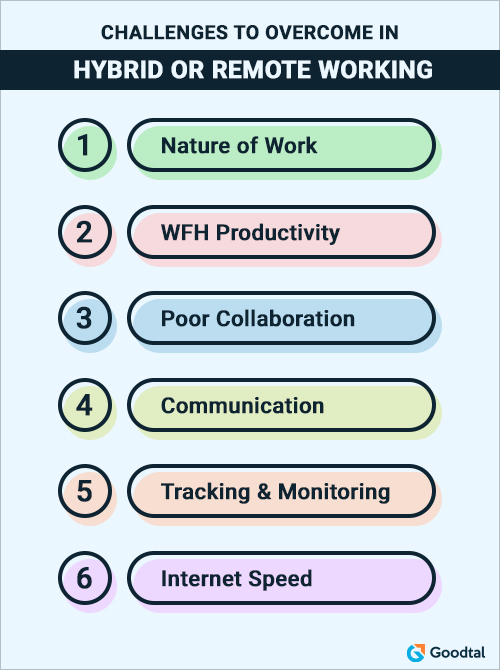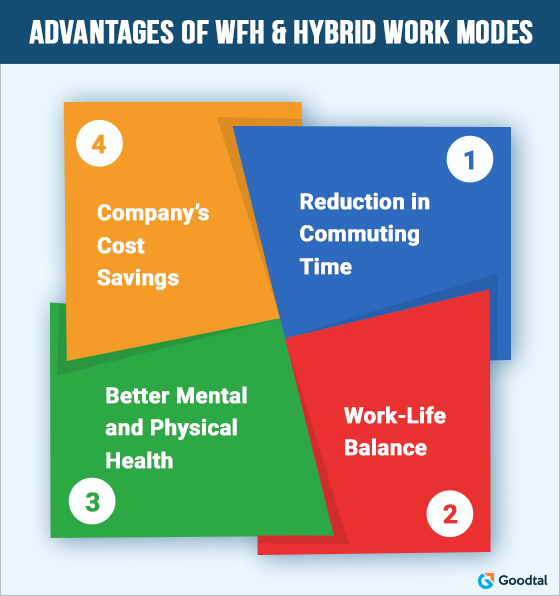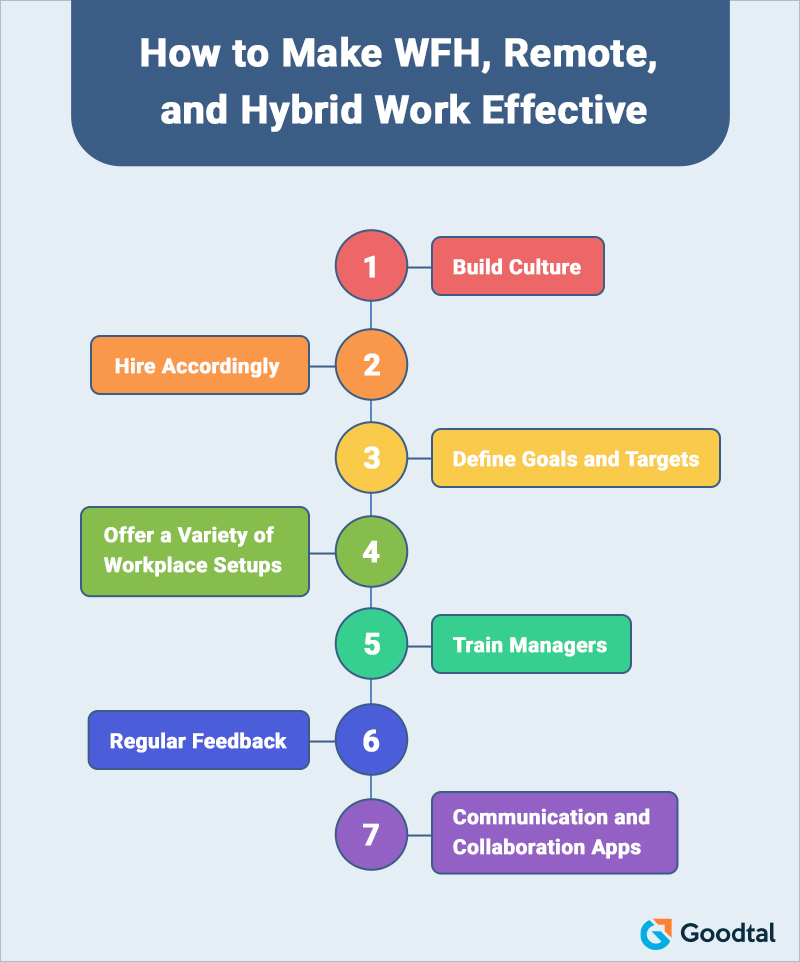
The last two years have seen a rapid increase in businesses allowing employees to work from home or anywhere. Some have permanently switched to Hybrid work mode due to employees' preferences. Though it was initially due to the pandemic and they did not have a choice, businesses gradually realized that for various jobs, it was feasible to continue this mode of working as it was not negatively affecting employee productivity. However, productivity is still the biggest concern for some businesses trying to adopt different Remote or Hybrid working modes.
“According to the study by Standford, working from home increases productivity by 13%. It was observed that this increase in performance was due to convenient working environment and fewer breaks or sick days. This study also shows that workers reported improved work satisfaction, and decreased attrition.”
The statistics above sound convincing. However, not everything is easy for businesses planning to switch to Work-from-home, Remote, or Hybrid setups. There are some challenges with these work modes, and businesses must prepare for these.
Challenges to Overcome in Hybrid or Remote Working
Work-from-home or Hybrid modes of working are posing certain hurdles for businesses. The most common of these are discussed below.

Nature of Work
Some types of work require the physical presence of the employees on the site. For these, switching to WFH, Remote, or Hybrid work modes is almost impossible.
WFH Productivity
Many believe that Remote, WFH, or Hybrid work modes are vulnerable to lower productivity. There are observations and data both in support and against this argument.
Poor Collaboration
People must work together on specific types of projects to make them effective. However, the level of collaboration required is different for different tasks, and specific tools or technologies are required to achieve the desired collaboration in Remote work or Hybrid work modes.
Communication
The absence of face-to-face communication can often be a barrier to effective communication between individuals or teams. It can also become a hindrance to team bonding.
Tracking & Monitoring
Tracking and monitoring employee work hours and productivity is challenging in Remote, Hybrid, or WFH modes. However, this challenge is relatively simple and can be overcome with simple tools and technology.
Internet Speed
Internet connectivity is, though, not a problem in most places. It can be a significant constraint in remote working in specific remote locations which don’t offer high-quality internet access.
If your business has tried WFH, Remote, or Hybrid models, you must have faced challenges apart from those above. However, most of these challenges are teething troubles or caused due to initial resistance to change. Businesses can easily overcome these challenges with experience and using the right technology solutions.
Merits of WFH & Hybrid Work Models
Despite the challenges, the new working models, i.e., WFH, Remote, and Hybrid, are the future of successful businesses, and these will continue for the merits.

Reduction in Commuting Time
Top cities across the world face traffic and distance issues, causing loss of significant work hours for businesses. WFH, Remote, or Hybrid modes of work solve this problem. The hours saved from commuting in high traffic can then be put to productive use. It also reduces physical and mental stress.
Work-Life Balance
Although different people have different opinions about this, work-life balance is one of the most sought-after reasons for employees opting for WFH or Hybrid work models. Employees working from home for a few days or a few hours have the privilege of focusing on the essentials of life, such as cooking healthy food, physical exercises, interacting with their kids and other family members, etc. They can also take care of their personal obligations during the break and continue to work better even during odd hours in the evening without the pressure of reaching back home on time.
However, this applies to businesses that do not expect employees to work beyond work hours or on the weekends.
Better Mental and Physical Health
WFH, Remote, or Hybrid facilitate working in comfortable setups and environments. When employees are comfortable, they can focus on their mental and physical well-being by having food, regular workouts, etc. They can also use their spare or break time to pursue their hobbies. Better mental and physical health help improve the performance of the employees significantly.
Company’s Cost Savings
Businesses offering WFH, Hybrid, or Remote modes of work save significantly on infrastructure and day-to-day operations costs. Such cost savings can be used to provide performance incentives and rewards for high-performing employees.
How to Make WFH, Remote, and Hybrid Work Effective
To be effective, Remote, Hybrid, and WFH require the right company culture and hard-working employees who can keep themselves motivated in any work mode.
Both employees and employers have their roles to play in getting the best from WFH, Remote, or Hybrid work modes. And there are ways of measuring performance to reward those who can adapt well to these modes and ensure they are productive.
Let’s see what employers can do to make WFH, Hybrid, or Remote work effective and productive.

Build Culture
Businesses must create a strong work culture supporting changes to accommodate employee well-being and increase productivity. Agility is the key to successful businesses. Moreover, offering multiple, flexible work modes makes the company lucrative for top talent.
Hire Accordingly
Businesses that allow flexible working modes should make clear policies while hiring employees. Also, they should hire employees capable of keeping themselves productive and motivated in all work modes. If it is impossible to identify this at the time of hiring, performance measurement can be used to identify those capable of productively working from home without even being monitored.
Define Goals and Targets
No matter where the employees are working from, the goals, targets, and deliverables should be clearly defined and communicated to the employees. Goals and expectations should be measurable, and timelines should be discussed with the employee. There should be clear performance parameters so employers can focus on performance without bothering about continuous monitoring.
Offer a Variety of Workplace Setups
Most successful businesses in the last two years have adopted new working modes. Many offer their new hires the option of working from home or the office. Some are allowing the employees to work for some days from the office and the rest from home. A variety of offers that suit the needs of employees make the company a preferred employer, and people are keen to join them.
Train Managers
WFH, Hybrid, or Remote working modes are not new for us. Many businesses have successfully implemented these. They have managed to get the best productivity from their teams working from anywhere. The key to successful management of these work modes is to train the managers on effective collaboration, communication, use of technology, etc.
Regular Feedback
Businesses should also encourage regular feedback from both managers and their teams on how they are coping with Hybrid or WFH modes of working. Based on the feedback, systems and performance of the workforce can be improved each day. Continuous improvement can make it possible for employees to be productive and increase business growth irrespective of their work modes.
Communication and Collaboration Apps
The use and development of Cloud technology solutions are increasing each day, making it convenient for businesses to adopt different and flexible work models. 360-degree cloud-based applications make collaboration easier in teams working from anywhere. Employees can create, store, share, and modify documents, spreadsheets, presentations, etc. They can work together from anywhere on large projects scattered over teams located globally.
Businesses are going for customized software development to build communication applications, audio/video chat applications, screen sharing apps, meeting managers, shared to-do lists, and many more. Software customized for the requirements of businesses makes communication between teams seamless, irrespective of where the members are physically located and even when commuting or traveling.
Wrapping Up!
Businesses are increasingly adopting a Remote or Hybrid mode of working as the employees are embracing this trend. There are challenges in shifting to Hybrid or completely Remote mode, but these can be managed easily using appropriate software solutions.
This blog discusses various applications that can make Hybrid or work-from-home comfortable for the employees and lucrative for the business. Businesses can either opt for ready software or customized app development to make the best out of remote or Hybrid work modes and increase overall productivity.
